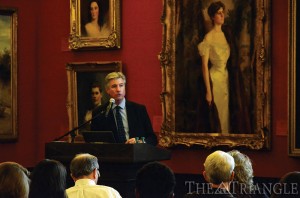James Young, one of the jurors on the committee that chose the design for the National 9/11 Memorial in New York City, spoke Oct. 15 in Drexel University’s Curtis Hall. Young’s talk, titled “How We Remember,” focused on the architecture of memorials and the various strategies required for building the most effective memorials.
Young teaches about memory at the University of Massachusetts Amherst. He is a leading scholar of the Holocaust and its memorials and has most recently studied how nations commemorate national catastrophes.

A successful memorial, Young said, interacts with the community and builds some kind of connection — something that doesn’t just document the event but opens it up and invites us to remember it. He believes the Vietnam War Memorial in Washington, D.C., is one of the most effective memorials in the world. Mostly, he explained, for the way it invites people down into it, providing a space underground for people to mourn.
It is common for memorials to be surrounded by controversy. In fact, Young has faced some backlash in his design of the National 9/11 Memorial because of its gift shop.
“There’s a cold economic reason for it,” Young said. “They don’t want to charge admission, and right now they won’t. But traditionally, visitors come to these places and want to take something back with them. People go to places like Auschwitz and buy ice cream. It’s part of our culture. People need to take away a little piece of what they found there.”
Students and faculty responded to Young’s talk with intrigue. Overall, most described it as interesting because of its illumination of everyday structures.
“Living in Philly, you’re kind of surrounded by memorials of all shapes and sizes, and knowing their context makes them much livelier. Otherwise, they can be kind of drab and invisible,” Young said.
The National 9/11 Memorial consists of two recessed pools in the form of voids in the ground, which are the same size and in the same location as the World Trade Center towers that fell on Sept. 11, 2001. Young said that the purpose of this design is to allow us to recognize the loss and absence of those towers as well as the people whose lives were lost inside them.
Young added that the rows of deciduous trees surrounding these spaces are meant to represent the annual cycle of rebirth and to provide a deeper feeling of regeneration and life, buffering the fundamental reminder of death.
“Usually when we visit a memorial, we end up remembering our visit to the memorial more than the event itself,” Young said. “We remember what we ate there, what we wore, who we saw, what the weather was like. Human beings are kind of caught up in the tactile moment. I think the memorials that settle us down allow us to go inward and really experience it.”
Young said that memorials that include “keep quiet” or “no running” signs are not successful because these are an extension of the authoritarian oppression that most likely led to the tragedy being represented. This is especially true for Holocaust memorials, Young said.
“I think everyone remembers everything in their own way. Memorials tend not to unify memories as much as they might unify the meanings of those memories. You don’t tell people what to think or what to remember. You allow people to bring their own experiences and knowledge to the space of remembrance,” Young said.

